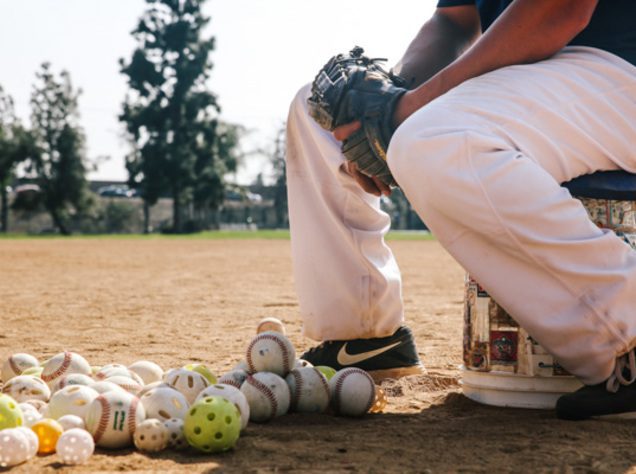Mixing Mental Exercises Into Your Baseball Workouts
To the casual viewer, baseball might seem like a game of home runs or diving catches, but, ultimately, that couldn’t be further from the truth. In fact, most of the success you’ll find in baseball comes from being accurately and intelligently sharp. All the best physical traits in the world often don’t hold a candle to the wits and understanding of the game.
Quick, here’s a pop quiz for you: You’re playing first base, there’s a runner on third base, one out. A sharply hit ground ball comes back to you at distance far enough from the bag that you must make one of two choices as the runner on third goes home:
A. Throw Home
B. Go to First
OK, fine, we’ll admit, that’s a bit of a trick question, since there are tons of variables to consider before making any sort of concrete decision. What’s the score? What’s the inning? Who is on deck? Believe it or not, all of these answers significantly impact your choice, so knowing what to do before the pitch even comes is key. Try to run through a mental baseball workout plan to prepare yourself for everything. Thankfully, CoachUp has got you covered — take our helpful tips and blossom into the most agile, fluid athlete you can be!
For Hitters
Luckily, for hitters, most of their decisions will be helped along by your coaches, but knowing the amount of outs are key. Obviously, most would say that getting on base is the sole goal of hitting, however, that’s not always the case. In tight, one-run games, often moving along any baserunners is enough to consider an at-bat a success. Additionally, striking or popping out can be a way towards losing at-bats in the long-run.
Simply put, your goal is to get on-base at any cost — via base hit, home run, walk, hit-by-pitch, bunt, whatever — but, you haven’t necessarily failed when you get out if you’ve moved the runners along. Typically, this relies on the hitter to force fielders into difficult decisions or intentionally hit sacrifice flies or bunts. It may seem obvious, but striking out is the worst thing you can do — you don’t get on-base and it offers absolutely no opportunity for baserunner advancement.
So, the next time you’re up with one out and a runner on second with two strikes, don’t try to swing for a home run. Try to shorten your swing and make sure you get contact on the ball. At that point, it’s out of your hands and up to the fielder to make the right decision!
You’re at-bat, runners on second and third with just one out; if we rule out a clean base hit, what should your attempted end goal be?
A. Squeeze Bunt
B. Groundout to shortstop
C. Strikeout
D. Sacrifice Fly
If you said D, you’re right! In all likelihood, unless you’ve got Mike Trout or Yasiel Puig patrolling the outfield, a deep fly to center or right should more than enough to advance one runner home and the other to third. In some situations, answer A would be an acceptable answer as well.
Now there’s a runner on first base, your team is down one run. Generally speaking, you’ve struggled against the pitcher today, going 0-3 at the plate with two strikeouts and a weak fly out — what should you do?
A. Strikeout again
B. Ground into a double play
C. Sacrifice Bunt
D. Ask for a pinch hitter
If you said C, you’re right! Even if you weren’t struggling at the plate, it might be a smart call to guarantee that you’ll move the runner along into scoring position. Small ball, a strategy that has died out over the last few decades, helps teams manufacture runs when things aren’t going that well in the box. A walk followed by a stolen base and sacrifice bunt, capped off by a sacrifice fly can score a run for any team without even needing a base hit!
For Fielders
We recently touched on this in the article about executing double plays, but the sentiment for this baseball workout plan remains the same. Often enough, the best fielders aren’t the ones that dive and jump their way through an inning — no, that distinction goes to the athlete that is mentally sharp and ready before each and every pitch.
Do you know where you’re going with the ball if you get it? Does the situation call for a double play or do you just need the force out at first? Is there on a runner on third?hoo All in all, try not to react to a hard hit ball while also attempting to make important decisions because that will only lead to errors and hesitation.
For outfielders, they need to be situationally aware of where to go with the ball after base hits or fly outs. Should you hit the cut-off man? Should you go to the plate? Is there a rush? Should you get a crow-hop position pre-catch? Will you attempt to throw out a tagging runner? Try going over these baseball workout plans in your head before the ball is coming your way — when that happens, it gets much harder to make an accurate throw.
For this scenario, try imagining this: you’re in centerfield, your team is winning 2-1, bottom of the seventh, runner on third base. A fly ball is hit out towards you, what should you do?
A. Nothing, catch the ball, casually toss the ball into the second baseman
B. Crow-hop, try to throw the tagging runner out at home plate
C. Try to throw the tagging runner out at home plate
D. Throw to third base
OK, so this one wasn’t too tough — given the score, scenario, and situation, the obvious choice is to head home with the ball. If they score, the game is tied, so it’s worth giving it a chance. But, let’s try modifying this situation a little bit a try again.
Now, you’re in centerfield again, no outs, your team is winning 5-2, bottom of the sixth, runners on second and third base. A deeper fly ball is hit towards you, what should you do?
A. Nothing, catch the ball, casually toss the ball into the second baseman
B. Crow-hop, quickly hit your cut-off man
C. Try to throw to tagging runner out at home plate
D. Throw to third base
Here, the situation probably calls for something different — so, if you picked answer B, you’re likely right. Since the score is in your favor, the safer, more realistic play is to hit your cut-off man and keep the runner on first from getting into a scoring position. A deep, undependable throw from center to the plate won’t result in an out and another runner will advance, furthering their rally attempt. In this situation and baseball workout plan, holding the runner to first would also keep a double play alive for the following play. Bottom line — don’t get hasty and risky when you don’t need to! Keep the game simple and you’ll get the best results at the end of the day.
(Related: Read about making good decisions in the outfield here.)
Huddle Up
Ultimately, these decisions and results are directly in your hands, so use them wisely! Carefully weigh the pros and cons of each mental baseball workout plan before potentially harming your team. Remember, for each awesome play at the plate, there are plenty of responsible situations in which playing it safe helped put their team in a better position to win.
If you’re having trouble making the right choice or staying situationally aware at all times, consider booking one of CoachUp’s private trainers to help you out in your progression. Our talented, smart team will have your baseball workout plan in no time — what are you waiting for?
How useful was this post?
Click on a star to rate it!
Average rating 0 / 5. Vote count: 0
No votes so far! Be the first to rate this post.




